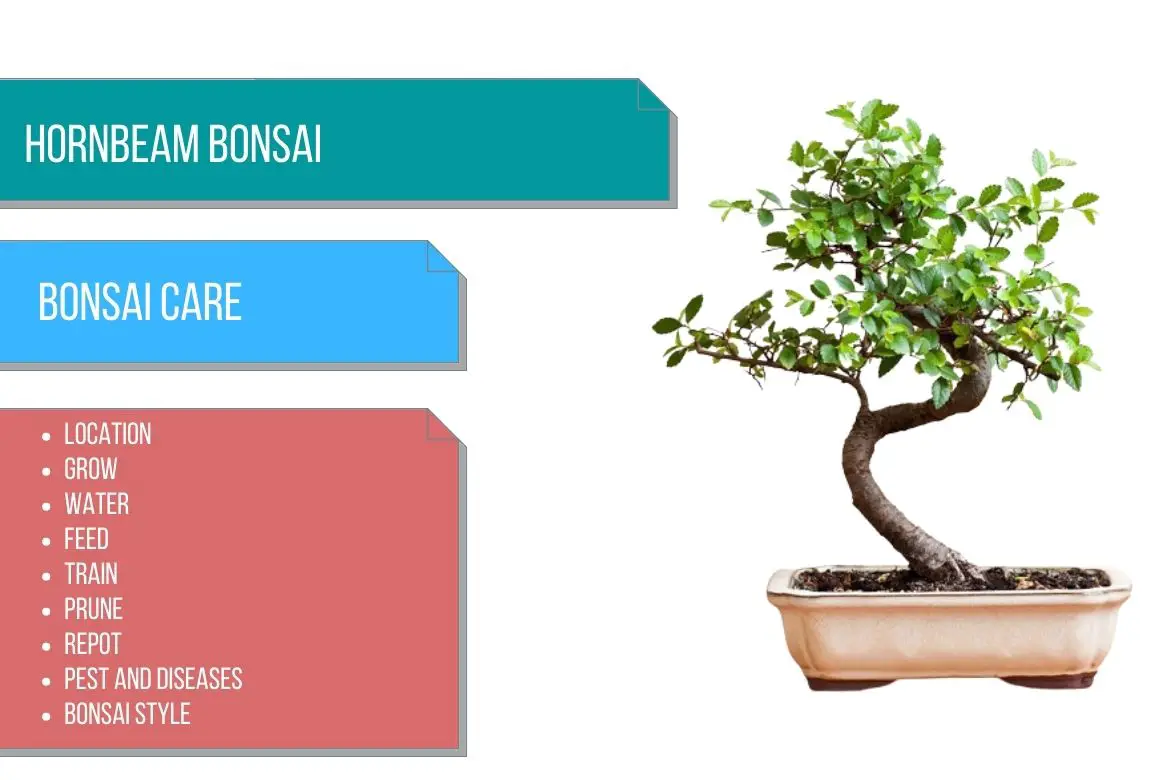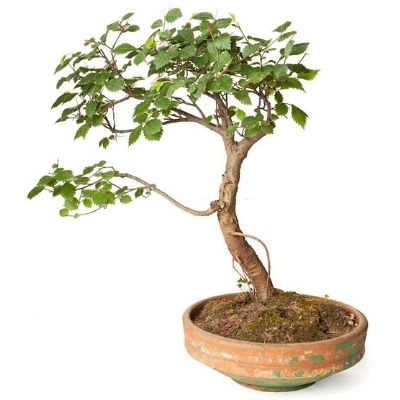
Hornbeam
(Carpinus)
Country of Origin : Southern Europe
Bonsai Styles : Informal upright, slanting, twin trunk, group
Zone : 5 – 9
The Hornbeam tree is native to cool temperate regions in Europe and Eastern Asia.
These trees have long, slender branches and oval, grooved leaves.
This vigorous tree has many bonsai-friendly qualities such as smooth, gray bark, fine branches, eloquent small buds, and an especially interesting trunk with sometimes an attractive deadwood..
Some of the hornbeam varieties used to make bonsai all over the world are listed below:
Japanese hornbeam Bonsai (Carpinus laxiflora)
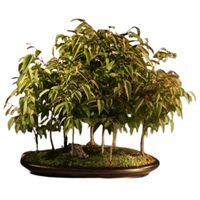
This variety of hornbeam is also known as ‘loose flowered hornbeam‘.
Japanese hornbeam leaves are pointed, medium-green with serrated margins.
Fall turns the leaves golden yellow.
Pale gray bark on older trees develops darker gray, interconnected streaks that extend upward almost to the apex. The result is an extremely beautiful, ancient yet elegant bonsai. Trees that are grown rapidly at the beginning and then restricted in pots for some time can develop this pattern.
It is highly desirable to plant forest plantings of slender Japanese hornbeams with two-tone trunks.
It produces large autumn catkins
Korean hornbeam Bonsai (Carpinus turczaninowii)
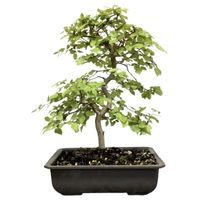
The leaves on Korean hornbeams are smaller, rounder, and slightly finer.
It has a dark gray, sometimes mahogany-tinted bark that remains smooth until it is very old.
The Korean hornbeam tree turns a brilliant orange in the fall, making it one of the few species that do so, and almost unique in bonsai.
While the twigs and branches appear to be flexible, they are susceptible to cracking when bent too much. At first, bend each branch just a little bit and then at regular intervals, until you achieve the final position.
European hornbeam Bonsai (Carpinus betulus)

The bright green foliage of European hornbeams bonsai turns a brilliant yellow as autumn approaches.
The tree’s gray bark has a striped pattern and is ridged.
Often used as hedging in the garden, European hornbeam is also a good candidate for bonsai because of its upright and pyramidal structure.
In spring, it bears green and yellow catkins.
American hornbeam Bonsai (Carpinus caroliniana)
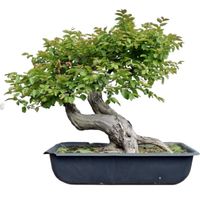
American hornbeam bonsai is slightly tougher and has a magnificent autumn display.
Unlike European hornbeam, American hornbeam has straight buds.
Leaf buds start out purplish red in color and change to dark green, yellow, and orangish red as the fall season arrives.
These trees are relatively fast growing and usually don’t need too much attention. Also, they are easy to train in many bonsai styles.
Carpinus laxiflora and Carpinus turczaninowii are the two most commonly used hornbeam varieties to make a bonsai.
For all other bonsai tree species you can grow, please read : Types of bonsai trees
Best location keep Hornbeam Bonsai
In theory, hornbeams can tolerate full sun. However, in hot weather the rate at which the roots of the plant absorb water from the soil is slower than the rate at which the plant loses its moisture from the leaves. This leads to scorching of the leaves.
Make sure you position the hornbeam bonsai away from direct sunlight after late morning.
For more information on how to keep your outdoor bonsai thriving in different seasons of the year, please read seasonal care for bonsai trees and outdoor bonsai tree care.
Some partial shade in midsummer will help the plant.
As long as the temperature does not drop below 19°F (-7°C), the tree can be left outside in winter. Protect the Carpinus plant in a frost free shed.
However, don’t keep it exposed to a temperature above 41°F (5°C) in winters. This might lead to the plant coming out of its dormancy.
Refer sunlight requirements for indoor plants for more indoor gardening ideas. Also, refer to do bonsai trees need sunlight for more indoor and outdoor bonsai location ideas.
Propagation Hornbeam
Stratify the hornbeam seeds in early spring and sow the seeds in fall.
Hornbeam can also be planted via softwood cuttings in midsummer.
Watering Hornbeam Bonsai
During growth, you should water frequently.
Water twice a day in summer and once a day in spring and fall.
In winter, reduce the frequency of watering. Just moisten the soil, and make sure the soil doesn’t get too wet. This will also reduce the risk of frost damage.
Make sure the soil is never allowed to dry out even slightly.
In shallow bonsai pots, monitor the moisture in the soil as shallow pots tend to lose moisture at a quicker rate.
Read watering bonsai tree for more details about immersion technique.
Wiring Hornbeam Bonsai
It is rare that hornbeams are wired to shape, but it can be done if necessary in spring or summer.
You can leave wires on young branches for about a year, and older, thicker branches for about two to three years.
Please read our detailed guide on how to wire a bonsai tree. Also, refer to our detailed bonsai tools guide and how to take proper care of your bonsai tools to know about all the tools of bonsai.
Pruning Hornbeam Bonsai
When to prune hornbeam bonsai?
It is possible to prune heavy branches at any time of the year, but it is best to prune them in the summer (preferably between leaf-fall and spring) when cuts will heal more quickly.
Spring and summer are ideal times to prune back shoots to promote fine branching.
New shoots should be trimmed to one or two leaves. The large leaves congesting the area should be removed during the growing season.
Refer to how to prune a bonsai tree for more info on best practices and tips and tricks.
Pinching Hornbeam Bonsai
Once two or three true leaves have formed, pinch out the growing tips of new shoots, and continue doing so throughout the growing season.
Repotting Hornbeam Bonsai
When to repot hornbeam bonsai?
In early spring, hornbeam plants should be replanted every two years until trees reach ten years of age, then every time their roots are potbound.
Too frequent repotting leads to large, coarse leaves and long internodes.
Apply Akadama or standard bonsai soil mix (free draining). However, if you are using akadama, be careful while watering as akadama has a tendency of staying wet for a long time.
Or, you can also use 60:40 ratio of organic matter and grit.
You can read how to repot a bonsai tree to know more about the best guidelines to follow while repotting.
Must Read: Bonsai Soil Recipes
Must read : Choosing the right bonsai container
Feeding Hornbeam Bonsai
A weak solution of general fertilizer should be applied once every other month to common hornbeams.
OR
Feed a balanced fertilizer from spring to late summer, followed by a low-nitrogen or nitrogen-free fertilizer in fall.
Low nitrogen feed will induce flowering.
Overfeeding will result in branches to thicken too much and leaves to become coarse and large. Overfeeding can also result in weak growth that is prone to scorching from the sun.
Read more about applying fertilizer to flowering bonsai tree in bonsai fertilizer and its application.
Diseases and pest of Hornbeam Bonsai
A systemic insecticide should be used to treat aphids.
Hand-removal of caterpillars is recommended.
In addition, hornbeams are prone to leaf spots, a fungus. The infected leaves should be picked off and destroyed. Apply a fungicide.
Refer the in-depth guide for bonsai pest and diseases identification and treatment for more details.
Also, read best practices to keep your bonsai pest free.
Hornbeam bonsai care
When not thinned and pruned regularly, inner branches and twigs can die back due to lack of light and air.
Trim all new shoots to one or two leaves and remove all larger leaves as they appear to maintain the finer twig structure.
To maintain a “breathing” space between the major branches, thin out the twigs in late winter by removing the shorter, finer ones.
The hot sun and drying winds can damage the leaves of hornbeams grown in shallow containers.
In addition, you should avoid misting or spraying plants that are standing in direct sunlight.
What to look for when buying Hornbeam Bonsai
Slender Japanese hornbeams with two tone trunk are highly sort after hornbeam varieties. However, they are easy to produce and widely available, hence they should not be that expensive.
Bonsai groups style or single trees bonsai style, most commercial hornbeams are of good quality.
However, always check the inside of the foliage before buying a hornbeam plant. Sometimes the dead twigs inside the foliage are covered by outer healthy leaves.
Also, make sure that the branch structure suits the bonsai style you intend to make.

